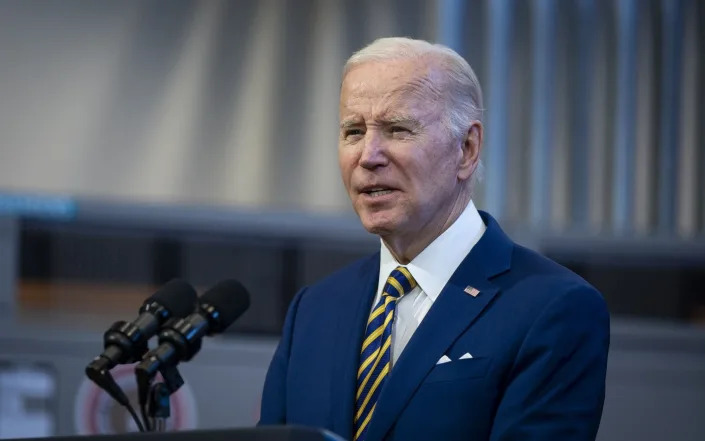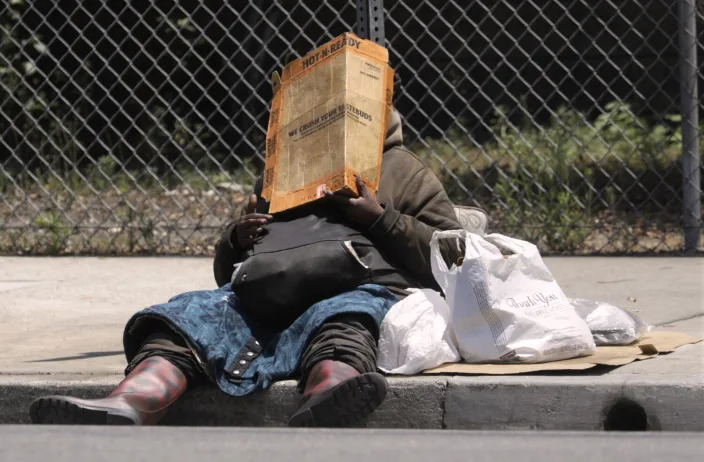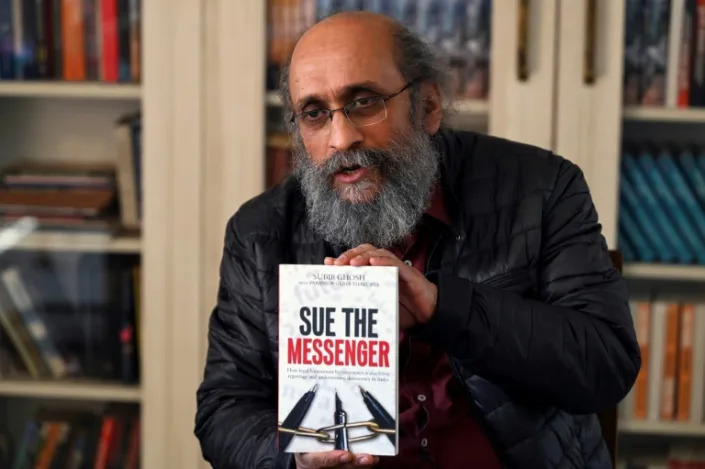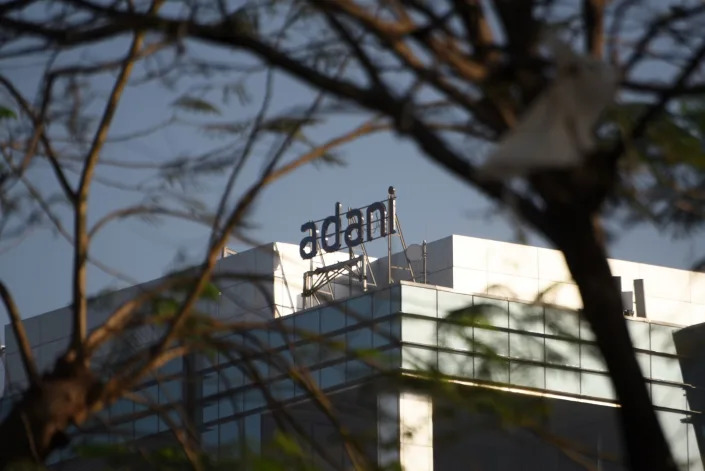Kwasi Gyamfi Asiedu, Cindy Carcamo
Sun, February 19, 2023

Sakshi Nanda, a foreign worker in Connecticut, was laid off by a health technology company last month. "I haven't processed the information yet. I am still in a state of shock," she said. (Christopher Capozziello / For The Times)
Sakshi Nanda has 28 days to find a new job.
Nanda is a foreign worker on an H-1B visa, and when a health technology company in Connecticut laid her off last month, a clock started ticking.
If she can’t adjust her visa status or find a new employer to sponsor her by March 19, she will have to abruptly pack up her settled life in the United States and return to New Delhi.
“I haven't processed the information yet. I am still in a state of shock,” she said.
Tech companies, including Alphabet, Facebook, Amazon and Microsoft, have laid off more than 100,000 workers in the U.S. this year, according to Layoffs.fyi.
Thousands of these workers are on the same clock as Nanda. Foreign workers on H-1B visas, which are used by tech companies to employ highly skilled non-U.S. citizens, have a strict 60-day grace period to find a new employer willing to sponsor them or leave the country. More workers could be vulnerable: 85,000 visas are granted annually under the H-1B scheme, and some reports estimate that more than 70% of tech workers in Silicon Valley were born outside the U.S.

Sakshi Nanda in her home office in Connecticut.
(Christopher Capozziello / For The Times)
For laid-off workers like Nanda, who has lived in the U.S. since 2019, the distress of being suddenly unemployed is compounded by the countdown.
“I don't think as an immigrant, you have the liberty to even process your emotions. … I have to find something within 50, 54 days because already my clock started ticking,” said Nanda, who has experience in business analytics and sales operations. “I don't have much time. Every day, it’s like a race against time.”
The layoffs do not mean that the skills of these foreign workers, some of whom were educated in the United States, are not needed, said David Loshin, senior lecturer at the College of Information Studies at the University of Maryland. He told The Times that several international graduates of the master’s program that he teaches have been affected by the tech layoffs. (Nanda graduated from his program in 2021.)
“It would be unfortunate for these skilled practitioners to have to be forced to leave,” Loshin said. “I think it would be valuable to review whether these are times where circumstances would allow for there to be extensions to those timeframes.”
For the most part, specialized work visas for foreigners are intended to be temporary. For example, a foreign worker with an H-1B visa can stay in the U.S. for a maximum of six years, which can be extended only in certain circumstances. The H-1B visa and status is initially valid for three years and can be extended for another three. After the maximum period of stay, the H-1B visa holder must either leave the U.S. or obtain a different immigration status.
Many people on work visas — especially H-1B holders — stay for much longer than the initial temporary period and keep renewing their visa while they wait to secure U.S. residency, said Julia Gelatt, a senior policy analyst at the Migration Policy Institute, a Washington, D.C.-based think tank. Backlogs for processing green card applications have ballooned over the last few years, and per-country caps for workers from particular countries, such as India and China, have forced many to wait decades to become legal U.S. residents.
In the meantime, workers build a life in their adopted country. Some have U.S. citizen children. Others purchase homes. Many integrate into their communities, planting deep roots.
For laid-off workers like Nanda, who has lived in the U.S. since 2019, the distress of being suddenly unemployed is compounded by the countdown.
“I don't think as an immigrant, you have the liberty to even process your emotions. … I have to find something within 50, 54 days because already my clock started ticking,” said Nanda, who has experience in business analytics and sales operations. “I don't have much time. Every day, it’s like a race against time.”
The layoffs do not mean that the skills of these foreign workers, some of whom were educated in the United States, are not needed, said David Loshin, senior lecturer at the College of Information Studies at the University of Maryland. He told The Times that several international graduates of the master’s program that he teaches have been affected by the tech layoffs. (Nanda graduated from his program in 2021.)
“It would be unfortunate for these skilled practitioners to have to be forced to leave,” Loshin said. “I think it would be valuable to review whether these are times where circumstances would allow for there to be extensions to those timeframes.”
For the most part, specialized work visas for foreigners are intended to be temporary. For example, a foreign worker with an H-1B visa can stay in the U.S. for a maximum of six years, which can be extended only in certain circumstances. The H-1B visa and status is initially valid for three years and can be extended for another three. After the maximum period of stay, the H-1B visa holder must either leave the U.S. or obtain a different immigration status.
Many people on work visas — especially H-1B holders — stay for much longer than the initial temporary period and keep renewing their visa while they wait to secure U.S. residency, said Julia Gelatt, a senior policy analyst at the Migration Policy Institute, a Washington, D.C.-based think tank. Backlogs for processing green card applications have ballooned over the last few years, and per-country caps for workers from particular countries, such as India and China, have forced many to wait decades to become legal U.S. residents.
In the meantime, workers build a life in their adopted country. Some have U.S. citizen children. Others purchase homes. Many integrate into their communities, planting deep roots.

If Sakshi Nanda cannot find a new employer to sponsor her by March 19, she will have to abruptly pack up her settled life in the United States and return to New Delhi. (Christopher Capozziello / For The Times)
Sixty days to look for a new employer who is willing to become a sponsor can feel dauntingly short. Some workers may have the option to switch to a visitor visa and stay, but they wouldn’t be allowed to legally work in the U.S. Others, including Nanda, may be eligible to switch to a spousal visa, but that process can take as long as six months, and applicants can't work while waiting for their application to be accepted or rejected.
“It really is a challenge, especially since many of the workers have really specialized skills and the more specialized someone’s skills, the more time it can take … to find a new job that fits their talents and abilities,” Gelatt said.
In 2019, 1.6 million people in the United States held temporary worker visas, according to Department of Homeland Security’s most recent estimates. That number includes the spouses and children of the temporary workers, who may or may not be able to work themselves, depending on the type of visa. DHS has yet to publish numbers for 2020 and 2021.
Some companies are eager to hire laid-off H-1B visa holders. “If you have recently been laid off and hold an H-1B visa, we would love to chat with you,” Joshua Browder, CEO of the San Francisco AI-based legal services start-up Do Not Pay, tweeted shortly after Facebook’s parent company, Meta, laid off thousands of workers in November. “25% of our team are not US citizens and we can move quickly.”
Browder usually has to pay a recruiting agency 20% of someone’s salary for talent.
But after his tweet, he received an overwhelming response — including 450 résumés. He didn’t have the capacity to hire nearly that many people.
“We got more résumés than we could handle,” he said. He made two offers and one hire and plans to hire more workers. He’s also sent some applications to his friends at other start-ups.
Browder, a 26-year-old immigrant from the United Kingdom, said laid-off tech workers on specialized visas are really struggling.
“It’s really a shame. These are, like, some of the most talented people I’ve ever seen. I’ve interviewed a lot of people in my career and these people are especially talented,” he said. “I think it’s really wrong that the system only gives them 60 days.”
Among those who have been laid off are foreign graduates of American universities and colleges who received Optional Practical Training work authorization after completing their studies. Those workers, like Srinivas Ch, have 90 days to find new employers.
Ch, 25, from India, graduated from the University of North Carolina at Charlotte in August with a master's in computer science. He was laid off — via email — in mid-January after just four months at Amazon.
“I felt really bad, I felt disheartened and eventually, I had to shed some tears as well,” he said. “Going into a FAANG company was always a dream for me; being passionate about software, being a software engineer, that was the biggest dream I ever had,” he added, referring to the industry acronym for Facebook, Apple, Amazon, Netflix and Google.
As his timeline nears, Ch spends his days mass-applying to dozens of jobs at a time. But few roles are open, and many companies are implementing hiring freezes. As for his family back home in India, he said they are “giving me moral support so that I don't get depressed and I keep moving on.”
Many of these tech companies have offered generous severance packages associated with weeks or even months of potential work, said Sophie Alcorn, who runs Alcorn Immigration Law in Mountain View, Calif.
“But, in the immigration context, the money doesn’t even really matter,” she said. “Most people in this situation have a lot of savings and they can afford to live here and not work for many months based on their emergency savings. The money is paltry compared to the immigration issues at stake.”
Since November, Alcorn has hosted numerous public webinars specifically for laid-off tech workers who are in the country with specialized work visas.
She believes that about 15% of all tech workers let go during the beginning of last year’s layoffs were immigrants. Alcorn came to that figure after analyzing the data from public lists in which laid-off tech workers looking for jobs self-identified their immigration status.
Alcorn said many of her clients aren’t willing to speak publicly about being laid off, fearing reprisal from potential employers or even from the U.S. government.
“This whole thing is shrouded in shame and secrecy for the people involved and who tend to come from cultures that value humility and following the rules and respecting authority,” she said.
During her online seminars, many chose to remain anonymous, typing up their questions in a chat. Sometimes the questions she gets aren’t so much about landing another job but how to manage family dynamics under such stress.
“How do I best prepare my family …?” one laid-off tech worker typed in a chat during a “Navigating the 2022 Tech Layoffs” webinar she hosted in November.
Alcorn choked up a bit reading the question.
“I have an 8-year-old and an 11-year-old. I think just being present, compassionate, loving. ... This is stressful,” Alcorn said. “Acknowledge that this is a strain on everybody. They know you are trying your best.”
U.S. Citizenship and Immigration Services, the agency that administers the nation’s naturalization system, “continues to monitor the U.S. labor market and economy when exploring procedural, policy and regulatory options to address related challenges faced by immigrant communities,” a spokesperson said. “USCIS remains committed to breaking down barriers in the immigration system.”
But any reforms, if they happen, would probably come too late for workers like Ch and Nanda. For now, they can only do one thing: “Apply, apply, apply, because you are racing against time and it's not a great feeling,” Nanda said.
“There's a lot of resilience being an immigrant,” she added. “We have had our own journey and struggles to come here so I'm not going to let that one job take that away from me. I'm going to fight till the end.”
This story originally appeared in Los Angeles Times.













